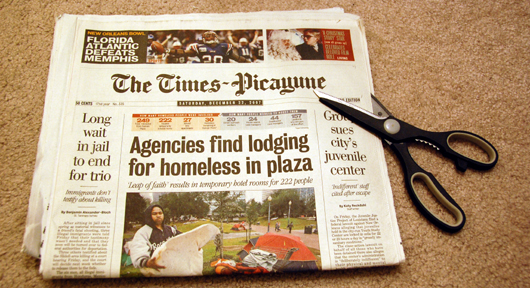
This post is pretty straightforward. Copy editors often are charged with trimming large stories into smaller ones, sometimes considerably smaller ones. It's increasingly becoming a reality as our readers' attention spans shorten. I'll just present my notes in bullet points for any editor who wants to pick up a few tips.
Types of trims
- An inch or two
- Slash and burn: cutting a story by several inches
- From a story to a brief
- From a story to a sentence or two (FLORIDA TODAY has a page of summaries for the big articles of the day. It's called the 5-Minute Read. Each item is a sentence or two.)
Obstacles
- Deadlines, especially online
- Shrinking news hole and staff size
- Pressure for shorter stories and fewer jumps
- Alternate story forms (design-heavy stories)
Options
- Make use of cutlines: Don't repeat the same information from the story.
- Let graphics and text boxes share the load: Again, this text shouldn't regurgitate the story.
- Use the Web.
- Cut carefully with the reader in mind.
An inch or two
- When a story is close to fitting, edit it thoroughly before trimming: Find words and phrases to cut.
- Trim excess details and quotes.
- Summarize and condense.
- Pull back lines if your publishing system allows it: Watch out for widows.
Slash and burn
- When you have a lot to trim, remember the inverted pyramid.
- Read, but don't edit, the entire story.
- Pick an ending point. Deal no more with what's below that point. (Turn a major trim into a minor trim.)
- Look for optional trims in wire copy.
- Keep the "new news."
- Keep the explainer (why you should care about the story).
- Keep the "talker" (something you would tell a co-worker tomorrow at the water cooler).
- Keep the methods and disclaimers on scientific and poll stories.
- Keep the he said/she said (both sides of the story).
- Cut the excess, and summarize the essential.
Caution
- Make sure you keep the first reference of names.
- Don't end on a transition.
- Make sure the story ends somehow, not necessarily with a quote.
Briefs
- Use just the facts: Leave out quotes.
- Craft a focused lede.
- Use quotes only if they're effective at getting the story across.
Web streamlining tasks
- Breaking news
- News updates
- Night-before stories (big teasers to print edition)
- Summaries for multimedia projects
- All of these elements require a short style, which often is achieved through trimming.
Breaking news
- When a car accident happens around 4:30 p.m., put the traffic information at top. Do this especially if people are injured. Later on, the lede might change to stress injuries or fatalities.
Session information
- Title: "Tighten Up! Trimming the Fat, Trimming to Fit"
- Time: 9 a.m. to 10:30 a.m. Saturday
- Panelists: Andy Bechtel, University of North Carolina; Lisa McLendon, Wichita Eagle
- Description: One of the underrates skills that a copy editor must have is the ability to trim: Cutting huge swaths, excising an unnecessary paragraph of two, posting parts of stories online first, even if the whole story is in. But trimming isn't just about fitting the story to the page. Just because there's unlimited space on the Web doesn't mean readers wants 1,600 words. This session will cover trimming for both situations: fitting stories into a print publication and streamlining for the Web.



No comments:
Post a Comment